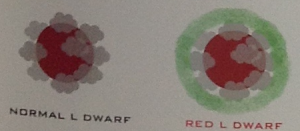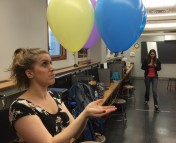Four hundred astronomers just spent the week together in Barcelona, Spain for the 17th Cool Stars conference, discussing stars, brown dwarfs, planets, and, of course, the advancement of Spain into the finals of the Eurocup! This week was my first Cool Stars meeting (see this astrobite and this one for some of our experiences at conferences), but there were some attendees who also went to the first one in 1980! It brings together experts in stellar astrophysics, brown dwarfs, and planets (in fact, the first brown dwarf and exoplanet discovered were announced at Cool Stars 9 in Florence, Italy!).
Instead of writing about the many exciting talks, splinter sessions, and discussions, I’m going to showcase the graduate student posters at the conference that won awards.
3rd place:
3rd place was a tie between Kay Hiranaka from Hunter College in New York City and Daniella Bardalez Gagliuffi from UC San Diego.

A schematic representation of the dust layer above a normal L dwarf (ipad camera shot--sorry for the quality!)
Kay Hiranaka is modeling how dust might affect brown dwarf spectra. Some L dwarfs have slightly different spectra than normal L dwarfs; it turns out that by applying a power law correction to redden the spectra, the strange L dwarfs actually look normal! This is similar to the way that we correct for interstellar dust reddening, but these objects aren’t far enough away for interstellar dust to be the problem. Kay instead suggests that these L dwarfs have an additional haze layer of small particles in their upper atmospheres causing this effect.
Daniella Bardalez Gagliuffi is working on observing systems of multiple low-mass objects. She discovered a system of three objects: one distant M7 star and a tightly-separated M8.5 and T5 pair (M dwarfs encompass the smallest stars; T dwarfs are the middle-temperature brown dwarfs, between the cold Y dwarfs and warmer L dwarfs). High-resolution spectra from the Keck telescopes allowed them to calculate the masses of the tightly-separated pair. Detecting low-mass triple systems like this gives us information about how star formation works down to much lower masses than we could previously study.

A cartoon of a transiting planet crossing a spotted star, with the corresponding light curve beneath.
2nd place
Joe Llama from the University of St Andrews won second place for his poster entitled “Things that go bump in the transit.” He’s working with Kepler light curves (aside: 82 astrobites currently mention “Kepler”) to determine whether we will be able to discover the latitude evolution of star spots (like the butterfly pattern on the Sun). They conclude that 3.5 years isn’t enough time to constrain the evolution, but an 8-year extended Kepler mission might be for some stars!
1st place
The winning poster was by Harvard graduate student Zach Berta, who is working on the MEarth project, which has been staring at the brightest nearby M dwarfs (the smallest stars) to discover planets. So far MEarth has discovered one planet, the super-Earth GJ 1214b. Zach is determining how to adjust the MEarth observing scheme to detect more planets.
MEarth is currently most sensitive to objects greater than 2 Earth radii in size; however, using statistical results from Kepler, it seems that planets with sizes greater than 2 Earth radii around M dwarfs are rare. To find more planets, we need to probe smaller radii. Zach’s new analysis concludes that MEarth will find more planets by pointing multiple telescopes at a single M dwarf. This new approach will give them fewer target stars to look at, but, given our new knowledge about planet abundances from Kepler, they’ll be able to see many more planets around them.



Trackbacks/Pingbacks